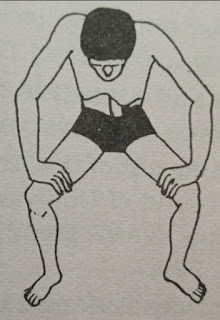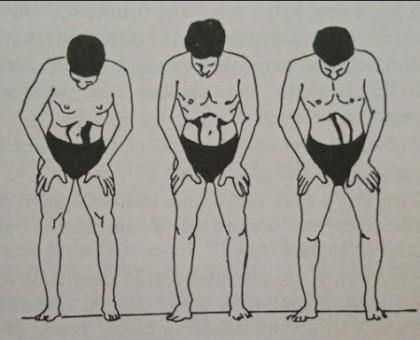NAULI
(The Projection and Manipulation of the Abdominal Recti)
Note:-
Caution : If the lungs, the heart or any of the important abdominal organs are weak or ailing, don't practise Nauli Kriya. If there is recurring stomachache, liver enlargement, appendicitis, any disorder of the spleen, etc., this Kriya should be performed under expert guidance.
Leading and Preparatory Practices : Tadagi Mudra, Uddiyana Bandha (without maintaining pressure on the thighs with the hands) (Chapter 32) and Dronasana (Chapter 16), etc., if practised, help in mastering the Nauli Kriya easily. So also, Madhya Nauli, Vama Nauli and Dakshina Nauli, if practised independently and long enough, help in the practice of Nauli Chalan.
To perform Nauli Kriya, one has to first attain Uddiyana Bandha. Although details of it are given in the preceding Chapter, we repeat its technique briefly, to ensure continuity of description.
How to fo Nauli Kriya :-
Starting position : Stand at ease, keeping a distance of about 30 to 40 cms. between the feet (fig. 1). Bend forward and slightly bend the legs at the knees. Place palms on the thighs, fingers facing inwards with elbows slightly jutting out (fig. 2). Breathe out completely, contracting the chest and abdominal muscles. Hold the breath out and do mock inhalation, expanding the chest and relaxing the abdominal muscles (fig. 3).
Fig. 1
Fig. 2
 Contract the throat and do not allow air to rush in. Apply Jalandhar Bandha i.e. fix the chin tightly in the jugular notch.
Contract the throat and do not allow air to rush in. Apply Jalandhar Bandha i.e. fix the chin tightly in the jugular notch.
Due to the negative pressure developed in the chest, the abdominal wall will cave in and the diaphragm be pulled upward automatically. The abdomen will appear concave. This is the final stage of Uddiyana Bandha (fig. 4) which is the starting point for all stages of Nauli Kriya.
Fig. 4
MADHYA NAULI OR NAULI MADHYAMA
(The Projection of the Middle Recti)
Technique of Performing the Nauli Kriya : Maintaining Uddiyana Bandha (fig. 4), increase the pressure of the hands on the thighs. With the help of this pressure, contract both the abdominal recti muscles so that they project automatically, leaving the other muscles behind. (Such is the action when applying pressure to evacuate the bowels.) The recti muscles which stand out in the abdominal cavity look as if they are thin pipes connecting the thoracic cage and the pubic bone. This process is called Madhya Nauli (fig. 5). Maintain this posture according to your capacity.
Eyes and Attention: Look at the abdomen and feel the sucking pressure at the diaphragm and the contraction of the recti muscles.
Fig. 5
Coming out of the Nauli Kriya : For coming out of Madhya Nauli, first reduce pressure of hands on thighs and let recti relax and go in. Next, bring the chest down and let abdomen come to its normal position. Separate neck and chin so as to resume breathing. Breathe in slowly and assume the starting position (fig. 1).
Practice : Perform 3 to 10 rounds of the Nauli Kriya. Probable Mistakes Correction
- Whole of abdomen comes out while doing Madhya Nauli.
- Pulling abdomen inside for applying Uddiyana Bandha.
- It is difficult to isolate recti muscles from the other muscles of the abdominal wall. This difficulty is surmounted by long practice giving particular attention to the recti muscles.
This technique of performing Uddiyana Bandha is wrong. If Uddiyana Bandha is not
performed properly, following the prescribed technique, one cannot successfully perform Nauli Kriya as Nauli is a play of positive and negative
pressures.
DAKSHINA NAULI (The Projection of the Right Rectus) Starting Position : Perform Uddiyana Bandha according to the technique explained earlier and going through positions as in figs. 1 to 4.
Technique of Performing the Nauli Kriya : Attaining Uddiyana Bandha (fig. 4) increase the pressure on the right thigh with the right hand and simultaneously reduce the pressure of the left hand on the left thigh. The right rectus abdominis muscle contracts and stands out. However, the left rectus abdominis muscle together with other abdominal muscles remains inside the abdominal concavity due to the inward pull. This Kriya is called Dakshina Nauli or the Projection of the Right Rectus (fig. 6). Maintain this pose according to your capacity.
Eyes and Attention : Look at the abdomen and feel the sucking pressure at the diaphragm and contraction of the right rectus.
Fig. 6
Coming out of the Nauli Kriya : For coming out, reduce the pressure of the right hand on the right thigh and relax the right rectus so that it gets pulled in. With this, one comes back to the position of Uddiyana. Now bring down the chest, relax the abdomen, raise the head and release the Uddiyana Bandha. Slowly breathe in and relax. Practice : 3 to 10 rounds.
Probable Mistakes
- Not being able to separate the recti muscles.
- Leaning to the right while pressing the right hand.
Correction
- Usually both the recti muscles work together and move together. Hence, a lot of practice is required to contract right rectus and simultaneously relax the left rectus, so as to cause only the right rectus to stand out for Dakshina Nauli.
be pressed on the right thigh without
- Right hand should
leaning to the right. VAMA NAULI (The Projection of the Left Rectus)
Perform this in the same manner as Dakshina Nauli but by pressing the left thigh with the left hand (instead of the right thigh with the right hand). Now, the left rectus stands out (fig. 7). This is the final stage of Vama Nauli. Maintain this according to capacity.
Eyes and Attention : Look at the abdomen and feel the sucking pressure at the diaphragm and fix the attention on the contraction of the left rectus.
Fig. 7
Coming out of the Kriya : Reduce the pressure of the left hand on the left thigh and relax the left rectus abdominis muscle so that it is pulled in. Thus come back to Uddiyana. Then bring down the chest, relax the abdomen, raise the head and release Uddiyana. Slowly breathe in and assume the starting position (fig. 1). Practice :
3 to 10 rounds. Probable Mistakes
- Not beingable to separate recti muscles.
- Leaning to the left while pressing the left hand.
Correction
- As both the recti muscles usually work and move together, lot of practice is required to contract left rectus and make it stand out, while relaxing the right rectus.
- Left hand should be pressed on the left thigh without
leaning to the left side.
NOTE:-
In one round of Uddiyana, one can practise Madhya Nauli, Dakshina Nauli and Vama Nauli one after the other. This practice will help you in mastering Nauli Sanchalana and Nauli Chalana.
NAULI SANCHALANA
(The Marching of the Recti Muscles)
When Dakshina Nauli and Vama Nauli are practised one after the other within one round of Uddiyana Bandha (figs. 8 and 9), the movements of the right rectus and left rectus
resemble the "left-right-left-right" movement of the legs of marching soldiers. Hence, this movement of recti muscles is called Nauli Sanchalana. This practice helps you in doing Nauli Chalana.
Fig. 8. Fig. 9

NAULI CHALANA (The Rotation of the Recti Muscles) Starting Position : Place the palms on the thighs, fingers curved inwards with elbows slightly out, and perform Uddiyana Bandha (fig. 4).
How to do Nauli Kriya
Technique of Performing the Kriya : Within one round of Uddiyana Bandha, take the right rectus muscle out (Dakshina Nauli) by pressing the right hand on the right thigh and next, take out both the recti muscles (Madhya Nauli) by pressing both the hands against the respective thighs. Follow this with Vama Nauli by reducing the pressure of the right hand and allowing the right rectus muscle to go in. Then reducing the pressure on the left thigh, allow the left rectus muscle also to go in thereby reverting to Uddiyana Bandha. This completes half a cycle of Nauli Chalana from right to left (clock-wise) 1.e. Uddiyana - Dakshina Nauli - Madhya Nault - Vama Nauli - Uddiyana. Release the Uddiyana Bandha and go to the starting position. Relax completely. Again perform Uddiyana and
practise Vama Nauli, Madhya Nauli, Dakshina Nauli and Uddiyana. This will complete the other half of Nauli Chalana (anti-clock-wise) 1.e. Uddiyana - Vama Nauli - Madhya Nauli Dakshina Nauli Uddiyana. Now within one round of Uddiyana, churn the recti muscles from right to left (clockwise) and left to right (anti-clock-wise), i.e. Uddiyana Dakshina Nauli - Madhya Nauli - Vama Nauli - Uddiyana and again Vama Nauli - Madhya Nauli - Dakshina Nauli and Uddiyana. This way one has to practise churning of recti muscles clock-wise and anti-clock-wise within one round of Uddiyana according to capacity. This is called Nauli Chalana.
Eyes and Attention : Look at the abdomen and follow the movements of the recti muscles.
Coming out of the Nauli Kriya : After churning the recti muscles In one round of Uddiyana (within your capacity) release the Uddiyana. Slowly breathe in and assume the starting position (fig. 1). Relax.
Practice : Perform 2 to 4 cycles of half of Nauli Chalana according to capacity. If the Dakshina Nauli, Madhya Nauli and Vama Nauli are quickly performed one after the other, they give an impression (due to optical illusion ) that both the recti muscles are moving in a circular fashion. When you can hold the breath longer, you can increase the number of cycles in Nauli Chalana Kriya.
Probable Mistakes
- Movements of the hips and body.
- Feeling out of breath due to maintaining Uddiyana beyond your capacity.
Correction
- In Nauli Chalana only recti muscles need to be moved. Hence, movements of the posterior and other parts of the body should be consciously avoided.
- Do not exceed your limit. Increase the capacity for maintaining Uddiyana through long, regular practice.
Nauli Chalana
NOTES :
1. Perform Nauli Kriya only on an empty stomach. If bowels and bladder are evacuated, one can perform this Kriya better. Therefore, morning is the best time for this Kriya.
2. In Yogic practices such as Basti, Vastra Dhouti, Shankha Prakshalana (1.e. cleansing of the alimentary canal from mouth to anus with water), etc. Nauli Kriya is most helpful.
3. Nauli Kriya can also be performed in a sitting posture like Padmasana (fig. 10) or even in a squatting position.
Fig. 10
Yoga tips:-
In Hatha Yoga, practices such as Asanas, Bandhas, Mudras, Pranayamas, etc. have not been planned in order only to attain normal health and maintain it. They have been devised in order also to develop in the aspirant supernormal physical and mental powers and siddhis. Therefore, often we find that the pulse rate, blood pressure, will-power, power of concentration, work efficiency, etc. of a Yoga aspirant differ from those of a normal person. For example, while blood pressure of 80/120 mm. of Hg is considered normal, the blood pressure of a Yoga aspirant can be 70/110, with no adverse effect on him.
In Yogabhyas directed towards acquiring superior powers, Pranayama occupies a prime place. But robust health is necessary before you practise it. If an aspirant of Pranayama suffers from disorders of Meda (Fat), Pitta (Bile) and Kapha (Phlegm), he must free himself from such disorders. For achieving this, Hatha Yoga prescribes certain important Shuddhi Kriyas (cleansing processes). It is said in Hatha Yoga that these disorders should first be removed with the help of the five elements namely Earth, Water, Fire, Air and Sky.
Nature has provided excellent built-in mechanisms for cleansing the body. However, civilization takes humans away from nature, making these mechanisms inefficient. But this machinery can be oiled again with the help of nature-based Yogic cleansing processes. Dhouti, Basti, Neti, Tratak, Nauli and Kapalabhati are the six important cleansing processes mentioned in Hatha Yoga. Of these, Nauli Kriya is rated to be the most effective.
The word "Nauli" means the chief muscles of the abdominal wall, in English called abdominal recti or recti abdominis. In Nauli, these recti muscles are separated from other muscles of the abdominal wall and rotated speedily at will. This process is called Nauli or Lauliki Kriya and the stages of this Kriya are appropriately named Madhya Nauli (Projection of Middle Recti), Dakshina Nauli (Projection of Right Rectus), Vama Nauli (Projection of Left Rectus) and Nauli Chalan (Circular Movement of the Recti).
Caution : If the lungs, the heart or any of the important abdominal organs are weak or ailing, don't practise Nauli. If there is recurring stomachache, liver enlargement, appendicitis, any disorder of the spleen, etc., this Kriya should be performed under expert guidance.
Leading and Preparatory Practices : Tadagi Mudra, Uddiyana Bandha (without maintaining pressure on the thighs with the hands) (Chapter 32) and Dronasana (Chapter 16). etc., if practised, help in mastering the Nauli Kriya easily. So also, Madhya Nauli, Vama Nauli and Dakshina
Nauli, if practised independently and long enough, help in the practice of Nauli Chalan.

















0 Comments